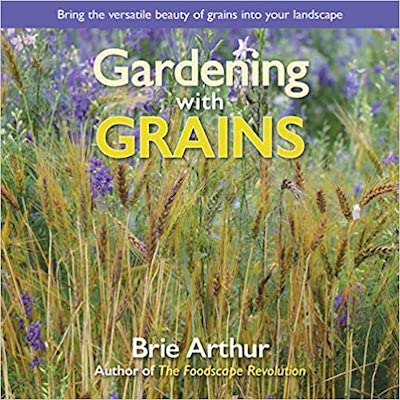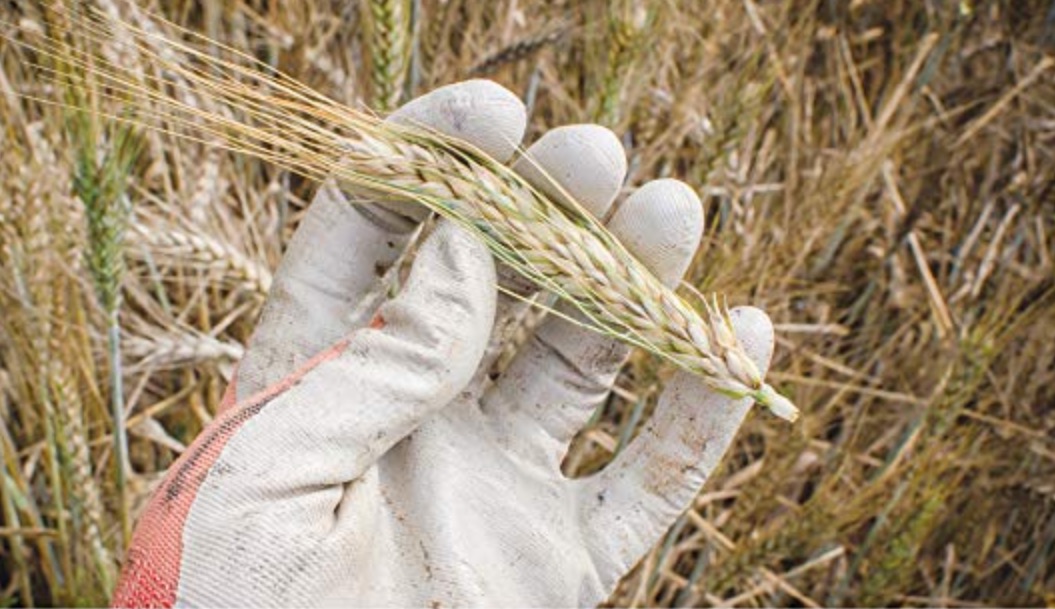Gardening with Grains
By George Graine, Fairfax Master Gardeners
“For amber waves of grain.” — from America the Beautiful (1893)
 If you are familiar with the name Brie Arthur, then you probably know that she is the author of “The Foodscape Revolution” published in 2017. This book explains how and why vegetables should be incorporated into your flower and shrub gardens. Brie is back with a new book called “Gardening with Grains: Bring the versatile beauty of grains into your landscape” (St. Lynn’s Press, 2019). She has taken on an additional and heretofore barely noticed plant family that is rarely considered as garden worthy by the home gardener. Pause for a moment when you realize how amazing it is that landscape designers have completely missed the point of incorporating grains into the landscape. Is it time?
If you are familiar with the name Brie Arthur, then you probably know that she is the author of “The Foodscape Revolution” published in 2017. This book explains how and why vegetables should be incorporated into your flower and shrub gardens. Brie is back with a new book called “Gardening with Grains: Bring the versatile beauty of grains into your landscape” (St. Lynn’s Press, 2019). She has taken on an additional and heretofore barely noticed plant family that is rarely considered as garden worthy by the home gardener. Pause for a moment when you realize how amazing it is that landscape designers have completely missed the point of incorporating grains into the landscape. Is it time?
Growing grains in your landscape is another game changer in the same manner as using vegetables outside of the typical rows and raised beds that are usually isolated from a “pretty” landscape. In other words, like the artistic expression where form follows function, so too can gardening with grains be both decorative and edible. Do you think that the subject of gardening with grains is of little consequence? Are you put off by thinking grains are limited to cooking and cereal products? (By the way, there is a cereal called Great Grains.) If so, you need to think more broadly. Wait until the last chapter in Brie’s book because it does include many recipes. The first eleven other chapters definitely measure up to the book title as she answers the question of why and how to garden with grains.
If you are in a hurry to learn how to garden with grains, then perhaps you should start your search half-way through the book with chapter 7, “Designing with Grains.” But to really get a feel for what grains are all about, then read chapters 5 and 6. These two chapters provide ample reason for the understanding of grains. Here you will find just six (out of hundreds) different types of cool season grains including barley, oats and wheat. Then you will read about three warm season grains that have a lot of visual appeal and may even surprise you. These are corn, rice and sorghum. Rice! Surely you have seen pictures of rice farmers planting rice in paddies. How is a home gardener going to maintain this plant? In a shallow pond! The fact is that growing rice in water is a weed suppressor. Therefore, the water acts as a natural herbicide. For gardeners, growing rice out of water will “work.” As an experiment, grow rice in a container. Water daily and make sure you locate the plant in a sunny location. Rice plants will also make a fine plant in the often used expression for container gardening — filler, spiller and thriller. Rice can be the thriller.
 All of the plants noted above are garden worthy in many respects. Grains are considered to be the easiest and lowest maintenance edible product to grow and they are also attractive-looking plants. Of course, to learn more, the internet will provide you with additional details but without any sort of passionate experience. In a relatively simple way, Brie glides you through an historical perspective, provides environmental benefits and along the way discusses some interesting personal stories about grains she has grown. Note that similar to familiar plants, grains too can make your garden interesting and aesthetically pleasing. They show off their colors, texture and structure. This is especially welcome when you consider planting grains in an interesting decorative pattern as a group, used as a screen or an eye-catching garden accent. When designing with grains, it is important to note that there is a significant difference between these plants and popular ornamental grass families such as pennisetum (fountain grass), miscanthus, calamagrostis (reed grass) and panicum (switch grass), just to name a few. The key difference is that grains are annuals whereas ornamental grasses are perennials. Grains will also supply food for humans, domesticated animals and wildlife. This is like a horticultural win-win in many respects.
All of the plants noted above are garden worthy in many respects. Grains are considered to be the easiest and lowest maintenance edible product to grow and they are also attractive-looking plants. Of course, to learn more, the internet will provide you with additional details but without any sort of passionate experience. In a relatively simple way, Brie glides you through an historical perspective, provides environmental benefits and along the way discusses some interesting personal stories about grains she has grown. Note that similar to familiar plants, grains too can make your garden interesting and aesthetically pleasing. They show off their colors, texture and structure. This is especially welcome when you consider planting grains in an interesting decorative pattern as a group, used as a screen or an eye-catching garden accent. When designing with grains, it is important to note that there is a significant difference between these plants and popular ornamental grass families such as pennisetum (fountain grass), miscanthus, calamagrostis (reed grass) and panicum (switch grass), just to name a few. The key difference is that grains are annuals whereas ornamental grasses are perennials. Grains will also supply food for humans, domesticated animals and wildlife. This is like a horticultural win-win in many respects.
 The first four chapters introduce you to the concept of why it is an excellent idea to grow grains. After this explanation is a brief introduction about how humans and cereal grains have a history together. This leads to a short discussion about ancient grains (think heirloom varieties) and modern-day cultivation. As an aside, you may have heard about the politically charged subjects of GMO — genetically modified organism and GE — genetically engineered. Both are technical terms that are caught up in scientific and political squabbles. Brie only briefly mentions them in layman’s terms. Her explanations are understandable and without taking sides one way or the other.
The first four chapters introduce you to the concept of why it is an excellent idea to grow grains. After this explanation is a brief introduction about how humans and cereal grains have a history together. This leads to a short discussion about ancient grains (think heirloom varieties) and modern-day cultivation. As an aside, you may have heard about the politically charged subjects of GMO — genetically modified organism and GE — genetically engineered. Both are technical terms that are caught up in scientific and political squabbles. Brie only briefly mentions them in layman’s terms. Her explanations are understandable and without taking sides one way or the other.
Not to be overlooked is a chapter on companion plants such as annuals, perennials and shrubs that work well with grains. Having this type of balance in your garden will provide biological diversity that is the mainstay for having a living ecosystem. Lest we forget, a short chapter on deer strategies is also included in the book. And finally, for the piece de resistance for those who like to cook as noted earlier, Brie included a mini cookbook filled with 25 mouth-watering recipes that use the grasses included in her book. You can dine on breakfast, lunch and supper delights. Make a salad, soup, pudding, cookies and more. Dine on!
In summary, Brie dedicated her book to all gardeners. In her own words she wrote, “Those from the past who left us a legacy of wisdom and eternal hope … Those in the present who serve and nurture the earth’s gifts … And those in the future, whose influence will shape generations to come: My gratitude.”